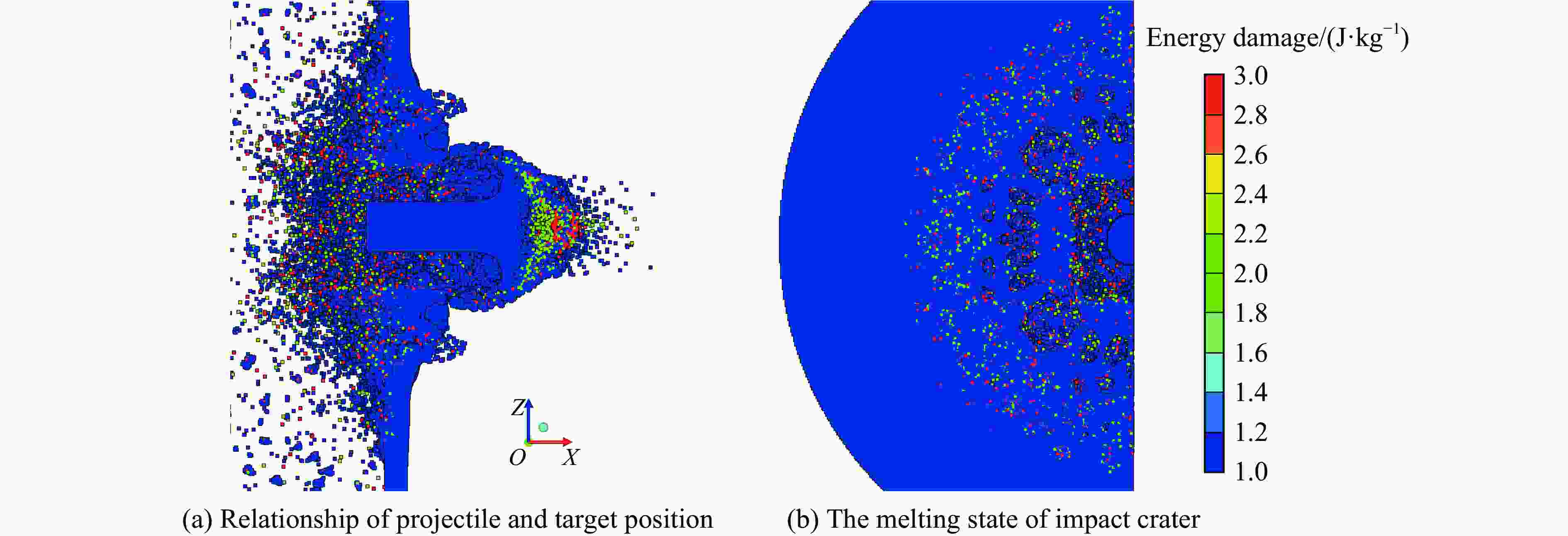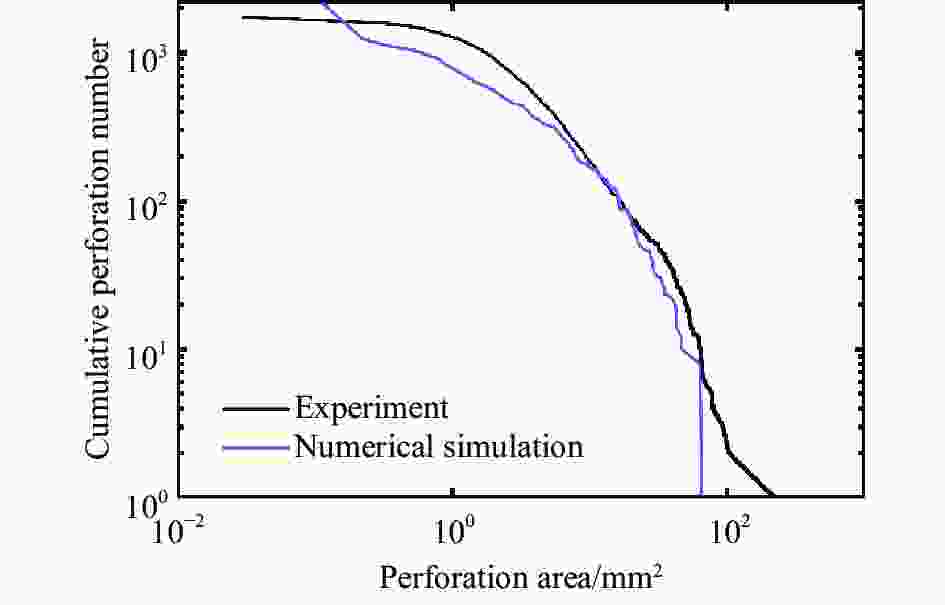The application of a modified constitutive model of metals in the simulation of hypervelocity impact
-
摘要: 为更加准确地计算93钨合金弹超高速撞击Q345钢板问题,构建了修正的金属本构模型。引入GRAY三相物态方程描述材料相态变化,采用Johnson-Cook强度模型描述撞击后期材料的力学行为。结合封加波损伤演化模型以及Johnson-Cook失效模型描述不同应力三轴度下材料的拉伸、剪切失效行为;引入曹祥提出的断裂演化模型,描述材料失效后应力归零的过程。通过对比超高速撞击数值模拟结果与实验结果,验证了本构模型的适用性,并进一步分析了典型弹靶撞击条件下破片群的空间分布特征。研究结果表明:基于修正金属本构模型获得的超高速撞击靶板穿孔直径、弹体侵蚀长度、破片群扩展速度结果与实验结果一致;GRAY三相物态方程能够相对准确地给出弹体撞击首层靶板以及剩余弹体、破片群撞击第2层靶板时弹靶材料的熔化情况;封加波损伤演化模型能够准确判断超高速撞击过程中靶板是否产生层裂破坏;综合封加波损伤演化模型、Johnson-Cook失效模型以及曹祥提出的断裂演化模型后,数值模拟获得的破片群撞击后效靶板的穿孔面积与累积数量的统计曲线结果与实验结果一致;获得了典型条件下的柱形93钨弹体超高速撞击Q345靶板破片群空间分布结果,破片群的前端具有较高的质量、轴向动量以及横向动量(绝对值)。
-
关键词:
- 超高速撞击 /
- GRAY物态方程 /
- 封加波损伤演化模型 /
- Johnson-Cook失效模型 /
- 断裂演化模型
Abstract: To accurately calculate the hypervelocity impact of 93 tungsten alloy projectile on Q345 steel plate, a modified constitutive model of metals is established. The GRAY three-phase equation of state is introduced to describe the phase change of the material, while the Johnson-Cook strength model is used to describe the mechanical behavior of the material in the late stage of impact process. Combined with the Feng’s damage evolution model and Johnson-Cook failure model, the tensile and shear failure behavior of materials under different stress triaxiality are represented. The fracture evolution model proposed by Cao Xiang is adopted to describe the process of stress vanishing after material failure. The applicability of the constitutive model is then verified by comparing the numerical simulation results with the experimental ones. Furthermore, the spatial distribution characteristics of fragment group in a typical process of a projectile impacting target are analyzed. The results show that based on the modified metal constitutive model, the perforation diameter of the target, the erosion length of projectile and the expansion velocity of fragment group of the hypervelocity impact are consistent with the experimental results. The GRAY three-phase equation of state can relatively accurately give the melting situation of the projectile and target materials when the projectile impacts the first layer of the target plate and the remaining projectile and fragment group impact the second layer of the target plate. The Feng’s damage evolution model can accurately judge whether spallation occurs during the hypervelocity impact. After integrating Feng’s damage evolution model, Johnson-Cook failure model and fracture evolution model proposed by Cao Xiang, the statistical curve of perforation area and cumulative number of aftereffect target plate impacted by fragment group obtained from the numerical simulation are consistent with the experiment data. The spatial distribution results of fragment group of cylindrical 93 tungsten projectile hypervelocity impacting Q345 target plate under typical conditions are obtained, and the front part of fragment group possesses high mass, high axial momentum and high transverse momentum by their absolute values. -
表 1 93钨合金、Q345钢GRAY物态方程及损伤演化模型材料参数
Table 1. The material parameters of the GRAY equation of state and the damage evolution model for 93 tungsten alloy and Q345 steel
表 2 93钨合金、Q345钢Johnson-Cook强度模型材料参数
Table 2. The material parameters of the Johnson-Cook yield criterion for 93 tungsten alloy and Q345 steel
材料 G/GPa Q1/MPa Q2/MPa Q3 Q4 Q5 Tm/K $\dot\varepsilon_0 $/s−1 93钨合金 132.00 600.8 1200 0.4944 0.059 0.8203 3683 0.001 Q345钢[24] 80.47 374 795.7 0.4545 0.01586 0.8856 1795 0.001 表 3 93钨合金、Q345钢Johnson-Cook失效模型材料参数
Table 3. The material parameters of the Johnson-Cook failure model for 93 tungsten alloy and Q345 steel
材料 D1 D2 D3 D4 D5 Tm/K $\dot{\varepsilon}_0$/s−1 93钨合金 0.09100 0.40900 −2.4600 −0.21800 1.613 3683 0.001 Q345钢 0.09436 1.15059 −3.0597 0.01645 0.240 1795 0.001 表 4 靶板穿孔直径的数值模拟结果与实验结果对比
Table 4. Comparison of numerical simulation results and experimental results of perforation diameter of the target plate
实验 弹直径/mm 弹长/mm 靶厚/mm 撞击速度/(m·s−1) 实验穿孔直径/mm 数值模拟穿孔直径/mm 误差/% 1 2.32 23.2 1.5 2847 5.357 5.493 2.54 2 2.92 14.6 1.5 3140 6.420 6.761 5.31 3 2.32 23.2 1.5 2300 5.008 4.907 −2.02 4 2.92 14.6 1.5 2180 5.566 5.755 3.40 5 3.45 10.5 1.5 3000 6.917 7.277 5.20 6 3.45 10.5 1.5 3010 6.808 7.279 6.92 7 3.45 10.5 1.5 3160 6.826 7.370 7.97 表 5 破片群扩展速度、弹体侵蚀长度数值模拟结果与实验结果对比
Table 5. Comparison of numerical simulation results and experimental results of fragment group expansion speed and erosion length of projectile
实验 弹直径/
mm弹长/
mm靶厚/
mm初速度/
(m·s−1)实验 数值模拟 误差 vx,max/(m·s−1) vr,max/(m·s−1) ΔL/mm vx,max/(m·s−1) vr,max/(m·s−1) ΔL/mm ε(vx,max) /% ε(vr,max)/% ε(ΔL)/% 7 3.45 10.5 1.5 3160 3143 837 3.40 3116 875 3.60 −0.86 4.54 5.88 8 2.92 14.6 1.5 2975 2953 738 3.21 2947 780 2.99 −0.20 5.69 −6.85 9 2.32 23.2 2.0 2180 2123 460 3.10 2149 458 2.84 1.22 −0.44 −8.39 表 6 不同靶厚与弹体直径比的破片群实验结果与数值模拟结果对比
Table 6. Comparison of experimental results and numerical simulation results of fragment group with different target thickness and projectile diameter ratio
实验 tt /dp 是否有“尖端” 高速摄像结果 数值模拟结果 7 0.435 有 

8 0.514 有 

9 0.862 无 

-
[1] 邸德宁, 陈小伟, 文肯, 等. 超高速碰撞产生的碎片云研究进展 [J]. 兵工学报, 2018, 39(10): 2016–2047. DOI: 10.3969/j.issn.1000-1093.2018.10.018.DI D N, CHEN X W, WEN K, et al. A review on the study of debris cloud produced by normal hypervelocity impact upon a thin plate [J]. Acta Armamentarii, 2018, 39(10): 2016–2047. DOI: 10.3969/j.issn.1000-1093.2018.10.018. [2] 宋光明, 武强, 李明, 等. 超高速撞击下空间碎片形状效应研究进展 [J]. 装备环境工程, 2020, 17(3): 45–52. DOI: 10.7643/issn.1672-9242.2020.03.008.SONG G M, WU Q, LI M, et al. Research progress in shape effect of space debris under hypervelocity impact [J]. Equipment Environmental Engineering, 2020, 17(3): 45–52. DOI: 10.7643/issn.1672-9242.2020.03.008. [3] 焦文俊, 陈小伟. 长杆高速侵彻问题研究进展 [J]. 力学进展, 2019, 49(1): 201904. DOI: 10.6052/1000-0992-17-021.JIAO W J, CHEN X W. Review on long-rod penetration at hypervelocity [J]. Advances in Mechanics, 2019, 49(1): 201904. DOI: 10.6052/1000-0992-17-021. [4] RANDLES P W, LIBERSKY L D. Smoothed particle hydrodynamics: some recent improvements and applications [J]. Computer Methods in Applied Mechanics and Engineering, 1996, 139(1): 375–408. DOI: 10.1016/S0045-7825(96)01090-0. [5] 周旭, 张雄. 物质点法数值仿真(软件)系统及应用 [M]. 北京: 国防工业出版社, 2015: 6–9.ZHOU X, ZHANG X. Material point method simulation system [M]. Beijing: National Defense Industry Press, 2015: 6–9. [6] LI B, KIDANE A, RAVICHANDRAN G, et al. Verification and validation of the optimal transportation meshfree (OTM) simulation of terminal ballistics [J]. International Journal of Impact Engineering, 2012, 42: 25–36. DOI: 10.1016/j.ijimpeng.2011.11.003. [7] 经福谦. 实验物态方程导引 [M]. 北京: 科学出版社, 1999: 25–29. [8] 唐蜜. 基于欧拉方法的超高速撞击程序研制及碎片云相分布数值模拟 [D]. 四川绵阳: 中国工程物理研究院, 2015: 45–51.TANG M. Development of hypervelocity impact codes based on Euler method and numerical study of the phase distribution in debris cloud [D]. Mianyang, Sichuan: China Academy of Engineering Physics, 2015: 45–51. [9] ZHANG X T, JIA G H, HUANG H. A fast numerical approach for Whipple shield ballistic limit analysis [J]. Acta Astronautica, 2014, 93: 112–120. DOI: 10.1016/j.actaastro.2013.06.014. [10] CHI R Q, PANG B J, GUAN G S, et al. Analysis of debris clouds produced by impact of aluminum spheres with aluminum sheets [J]. International Journal of Impact Engineering, 2008, 35(12): 1465–1472. DOI: 10.1016/j.ijimpeng.2008.07.009. [11] BEISSEL S R, GERLACH C A, JOHNSON G R. A quantitative analysis of computed hypervelocity debris clouds [J]. International Journal of Impact Engineering, 2008, 35(12): 1410–1418. DOI: 10.1016/j.ijimpeng.2008.07.059. [12] COLLÉ A, LIMIDO J, VILA J P. An accurate SPH scheme for dynamic fragmentation modelling [J]. The European Physical Journal Conferences, 2018, 183: 01030. DOI: 10.1051/epjconf/201818301030. [13] 邸德宁, 陈小伟. 碎片云SPH方法数值模拟中的材料失效模型 [J]. 爆炸与冲击, 2018, 38(5): 948–956. DOI: 10.11883/bzycj-2017-0328.DI D N, CHEN X W. Material failure models in SPH simulation of debris cloud [J]. Explosion and Shock Waves, 2018, 38(5): 948–956. DOI: 10.11883/bzycj-2017-0328. [14] POVARNITSYN M E, KHISHCHENKO K V, LEVASHOV P R. Simulation of shock-induced fragmentation and vaporization in metals [J]. International Journal of Impact Engineering, 2008, 35(12): 1723–1727. DOI: 10.1016/j.ijimpeng.2008.07.011. [15] EFTIS J, CARRASCO C, OSEGUEDA R A. A constitutive-microdamage model to simulate hypervelocity projectile-target impact, material damage and fracture [J]. International Journal of Plasticity, 2003, 19(9): 1321–1354. DOI: 10.1016/S0749-6419(02)00036-0. [16] FENG J P, JING F Q, ZHANG G R. Dynamic ductile fragmentation and the damage function model [J]. Journal of Applied Physics, 1997, 81(6): 2575–2578. DOI: 10.1063/1.363921. [17] SEISSON G, HÉBERT D, BERTRON I, et al. Dynamic cratering of graphite: experimental results and simulations [J]. International Journal of Impact Engineering, 2014, 63: 18–28. DOI: 10.1016/j.ijimpeng.2013.08.001. [18] CORBETT B M. Numerical simulations of target hole diameters for hypervelocity impacts into elevated and room temperature bumpers [J]. International Journal of Impact Engineering, 2006, 33(1): 431–440. DOI: 10.1016/j.ijimpeng.2006.09.086. [19] ZHANG X T, LI X G, LIU T, et al. Element fracture technique for hypervelocity impact simulation [J]. Advances in Space Research, 2015, 55(9): 2293–2304. DOI: 10.1016/j.asr.2015.01.040. [20] 曹祥, 汤佳妮, 王珠, 等. 损伤演化对韧性金属碎裂过程的影响 [J]. 爆炸与冲击, 2020, 40(1): 013102. DOI: 10.11883/bzycj-2019-0041.CAO X, TANG J N, WANG Z, et al. Effect of damage evolution on the fragmentation process of ductile metals [J]. Explosion and Shock Waves, 2020, 40(1): 013102. DOI: 10.11883/bzycj-2019-0041. [21] ROYCE E B. GRAY, a three-phase equation of state for metals: UCRL-51121 [R]. Livermore: Lawrence Livermore National Laboratory, California University, 1971. [22] 兰彬, 文鹤鸣. 钨合金长杆弹侵彻半无限钢靶的数值模拟及分析 [J]. 高压物理学报, 2008, 22(3): 245–252. DOI: 10.11858/gywlxb.2008.03.004.LAN B, WEN H M. Numerical simulation and analysis of the penetration of tungsten-alloy long rod into semi-infinite armor steel targets [J]. Chinese Journal of High Pressure Physics, 2008, 22(3): 245–252. DOI: 10.11858/gywlxb.2008.03.004. [23] GMX-6 Group. Selected Hugoniots: LA-4167-MS [R]. Los Alamos, NM: Los Alamos Scientific Laboratory, 1969. [24] 于文静. 导管架海洋平台钢结构在爆炸和火灾作用下的力学性能研究 [D]. 上海: 上海交通大学, 2012: 36–37.YU W J. Study on mechanical properties of steel jacket offshore platform in blast and fire [D]. Shanghai: Shanghai Jiaotong University, 2012: 36–37. [25] 钱伟长. 穿甲力学 [M]. 北京: 国防工业出版社, 1984: 336–340. [26] LIANG S C, LI Y, CHEN H, et al. Research on the technique of identifying debris and obtaining characteristic parameters of large-scale 3D point set [J]. International Journal of Impact Engineering, 2013, 56: 27–31. DOI: 10.1016/j.ijimpeng.2012.07.004. -







 下载:
下载:









